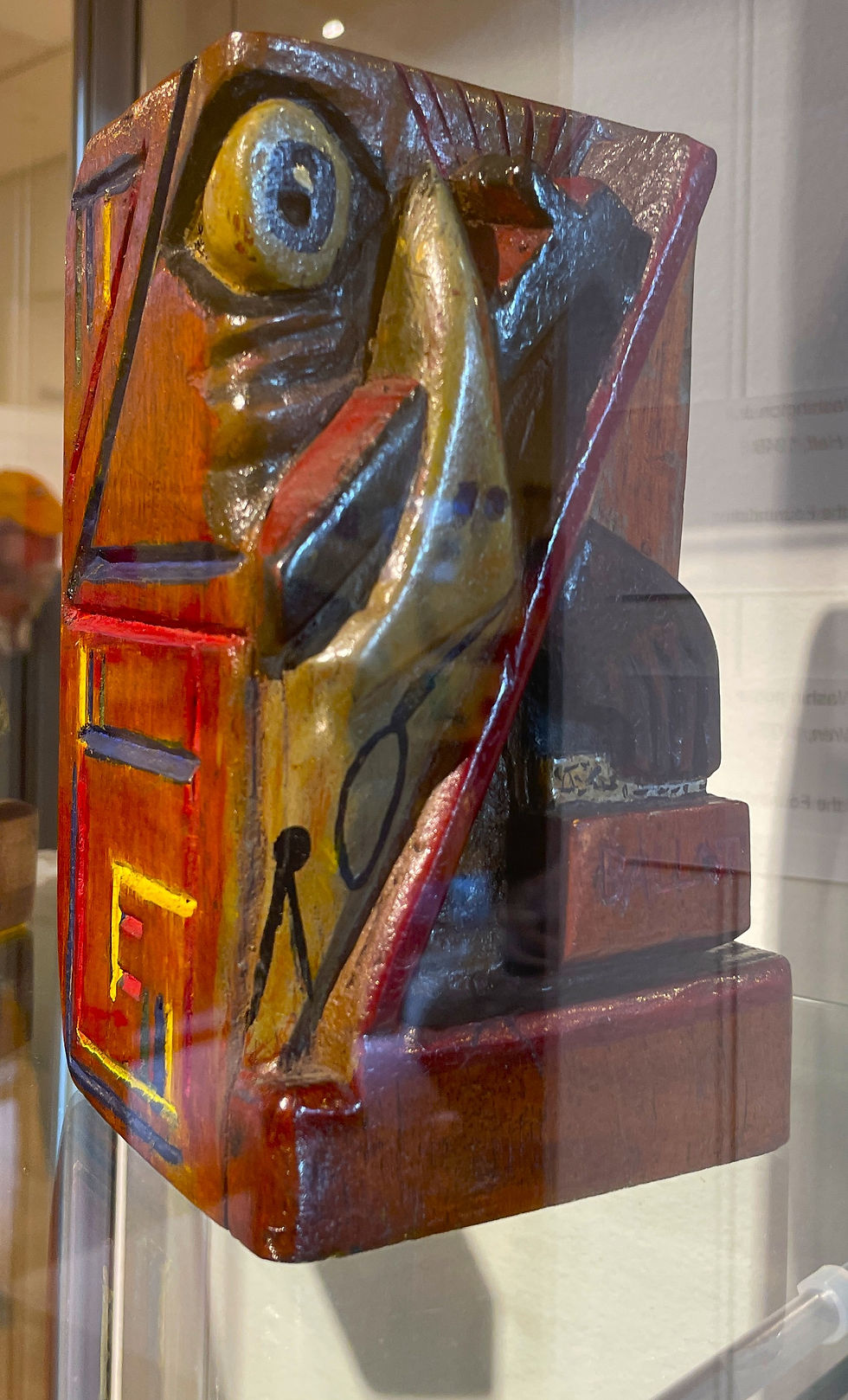“Many Hats, One Spirit”
- Susan Platt, PhD
- Aug 28
- 3 min read

As you walk from the ferry toward the Bainbridge Island Museum of Art, you will see a large photograph of James W. Washington, Jr. holding a chisel in the window. It announces his exhibition “Many Hats, One Spirit” at the museum until September 17.
Once inside the museum, climb the staircase, so you first view a life size bronze statue of Washington by Barry Johnson, a replica of the piece at Union and 24th street.
The statue is set in a re-creation of his living room with two enormous chairs and a table with books and a masonic hat. In the same space is an evocation of his studio with tools and stones.
Passing through glass doors, we are immersed in Washington’s works, as well as the contemporary artists whom he inspired. The exhibition is beautifully installed. A concentration of Washington’s works in the center includes early watercolors of intensely colored images of churches and streets from Mississippi, Arkansas and Seattle (Needless to say even in Seattle, as a Black man, he had to be careful about what and where he painted.)
In the earliest carving, a small block of wood with the title The Chaotic Half (1946), a hand reaches out to vote as a hooded character holds him back (what1 has changed since then?). Also from the 1940s—at the other end of the gallery—two paintings comment on the status of African Americans. In the Making of the UN Charter (1945) a horrified Black man is relegated to the lower right hand corner; Democracy Lynched (1946) depicts unbalanced scales of Justice with a Black family on one side being lynched.
Washington was involved in Civil Rights actions from early in his career, so these two paintings represent important statements in that trajectory. His archives give us a great many documents on Civil rights actions in Little Rock, Arkansas and Seattle.
In 1944 he moved to Seattle to work as an electrician in Bremerton with the civil service. A few years later he moved to Seattle and was permitted to set up a Shoe Repair Shop at Fort Lawton (1950).
At the same time he was also becoming known as an artist among the soon to be famous Northwest artists, especially Mark Tobey. Tobey and Washington shared an interest in spirituality. Furthermore, after a trip to Mexico in 1951 when he met Diego Rivera and David Alfaro Siqueiros, he picked up a small lava stone at Teotihuacan that was to lead to a decisive change in his art.
Four years later he sculpted Young Boy From Athens, from that rock, leading to his long career of sculpting stone. In the exhibition we see several examples of his bird sculptures, as well as portraits and spiritual symbolism.
One of the strongest portraits is Jomo Kenyatta (1962), not yet President of Kenya. We see here an inspiration for Charles Parrish’ small bronze portraits Desmond Tutu and Veteran shown nearby.
The Artist in Residence Program includes 25 former Artists in Residence. Carletta Carrington Wilson and Christian French showed work made during the residency. Carletta’s wonderful layers of fabric collage include a page from Harpers Weekly during the Civil War depicting negroes performing various duties. Christian French explained how he created his totem “from Polaroids I took onsite of stones around the studio and yard. Those were then scanned digitally and printed out larger on transparent material for the lightboxes, which I also assembled onsite.”

Mary Coss’ salt eroded metal suitcases suggest endless travel. Long dangling wires made words referring to migration and memory and speaking about her own family’s experiences. Marita Dingus, who made shoes on Washington’s sewing machine during the residency, exhibited a small spiritual collage figure titled Contemplation.
In one corner a group of hanging mirrors called Shaded by Christina Reed had one word on each side: “Unfounded/Suspicion, Fear/Ful, Deliberate/Ignorance, Evade/Truth, Constant/Vigilance, Deny/Access, Intended/Disregard.” As they turned on a wire, the message came through gradually.

On the Fence, an evocation of love and danger by Ursula Stuart, featured a heart shaped motif studded with nails and hung against a fence. Ursula also created a group of protective amulets, including a witch and a queen. She connects to Washington’s belief in the spirit. Likewise Squeak Meisel’s Leaving the Body suggests spiritual experiences in his quirky drawings.
There are many other works to enjoy, but primarily what we experience is Washington’s spirituality. Much of that spirit emanates from the materials used for the art, his own stone sculpture or the artists discovering everything from nails and rounded stones in the garden to a model of a slave ship in his historic home on 26th St in the Central District.

“Many Hats, One Spirit” is a landmark event perfectly curated to provide a provocative dialogue between Washington and the Artist Residents.
~Susan Platt
Comments